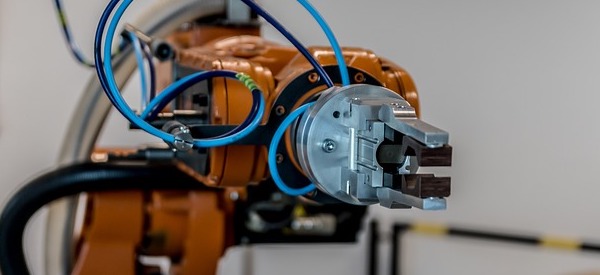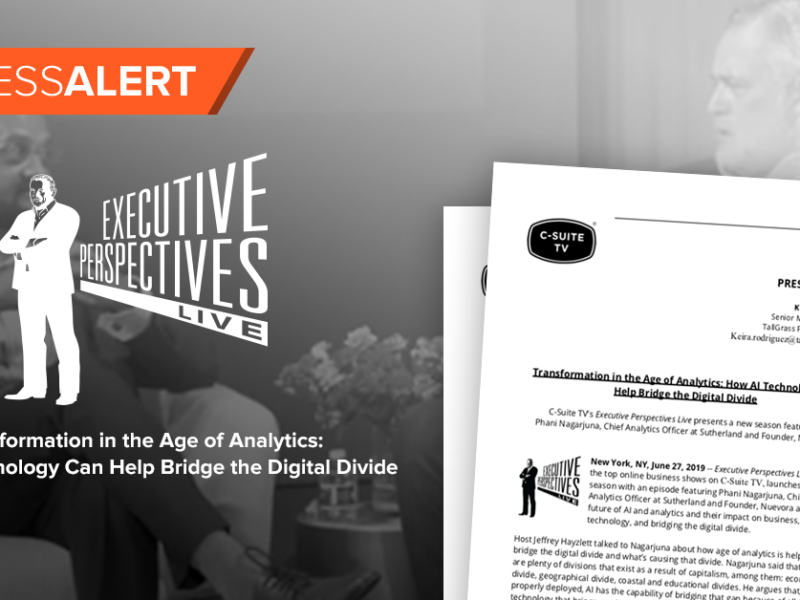
Are There Infinite Jobs?
Are There Infinite Jobs? https://csuiteold.c-suitenetwork.com/wp-content/uploads/2018/11/robot-2791671_640.jpg 600 275 C-Suite Network https://csuiteold.c-suitenetwork.com/wp-content/uploads/2018/11/robot-2791671_640.jpgThe following is an excerpt from GigaOm publisher Byron Reese’s newest book, “The Fourth Age: Smart Robots, Conscious Computers, and the Future of Humanity.”
The Fourth Age explores the implications of automation and AI on humanity, and has been described by Ethernet inventor and 3Com founder Bob Metcalfe as framing “the deepest questions of our time in clear language that invites the reader to make their own choices. Using 100,000 years of human history as his guide, he explores the issues around artificial general intelligence, robots, consciousness, automation, the end of work, abundance, and immortality.”
One of those deep questions of our time:
When the topic of automation and AI comes up, one of the chief concerns is always technology’s potential impact on jobs. Many fear that with the introduction of wide-scale automation, there will be no more jobs left for humans. But is it really that dire? In this excerpt from The Fourth Age, Byron Reese considers if the addition of automation and AI will really do away with jobs, or if it will open up a world of new jobs for humans.
In 1940, only about 25 percent of women in the United States participated in the workforce. Just forty years later, that percentage was up to 50 percent. In that span of time, thirty-three million women entered the workforce. Where did those jobs come from? Of course, at the beginning of that period, many of these positions were wartime jobs, but women continued to pour into the labor force even after peace broke out. If you had been an economist in 1940 and you were told that thirty-three million women would be out looking for jobs by 1980, wouldn’t you have predicted much higher unemployment and much lower wages, as many more people would be competing for the “same pool of jobs”?
As a thought experiment, imagine that in 1940 General Motors invented a robot with true artificial intelligence and that the company manufactured thirty-three million of them over forty years. Wouldn’t there have been panic in the streets about the robots taking all the jobs?
But of course, unemployment never went up outside of the range of the normal economic ebb and flow. So what happened? Were thirty-three million men put out of work with the introduction of this large pool of labor? Did real wages fall as there was a race to bottom to fight for the available work? No. Employment and wages held steady.
Or imagine that in 2000, a great technological breakthrough happened and a company, Robot Inc., built an amazing AI robot that was as mentally and physically capable as a US worker. On the strength of its breakthrough, Robot Inc. raised venture capital and built ten million of these robots and housed them in a giant robot city in the Midwest. You could hire the robots for a fraction of what it would cost to employ a US worker. Since 2000, all ten million of these robots have been hired by US firms to save costs. Now, what effect would this have on the US economy? Well, we don’t have to speculate, because the setup is identical to the practice of outsourcing jobs to other countries where wages are lower but educational levels are high. Ten million, in fact, is the lowest estimate of the number of jobs relocated offshore since 2000. And yet the unemployment rate in 2000 was 4.1 percent and in 2017 it is 4.9 percent. Real wages didn’t decline over that period. Why didn’t these ten million “robots” tank wages and increase unemployment? Let’s explore that question.
For the past two hundred years, the United States has had more or less full employment. Aside from the Great Depression, unemployment has moved between 3 and 10 percent that entire time. The number hasn’t really trended upward or downward over time. The US unemployment rate in 1850 was 3 percent; in 1900 it was 6.1 percent; and in 1950 it was 5.3 percent.
Now picture a giant scale, one of those old-timey ones that Justice is always depicted holding: on one side of the scale you have all the industries that get eliminated or reduced by technology. The candlemakers, the stable boys, the telegraph operators. On the other side of the scale you have all the new industries. The Web designers, the geneticists, the pet psychologists, the social media managers.
Why don’t those two sides of the scale ever get way out of sync? If the number of jobs available is a thing that ebbs and flows on its own due to technological breakthroughs and offshoring and other independent factors, then why haven’t we ever had periods when there were millions and millions more jobs than there were people to fill them? Or why haven’t we had periods when there were millions and millions fewer jobs than people to fill them? In other words, how does the unemployment rate stay in such a narrow band? When it has moved to either end, it was generally because of macro factors of the economy, not an invention of something that suddenly created or destroyed five million jobs. Shouldn’t the invention of the handheld calculator have put a whole bunch of people out of work? Or the invention of the assembly line, for that matter? Shouldn’t that have capsized the job market?
A simple thought experiment explains why unemployment stays relatively fixed: Let’s say tomorrow there are five big technological breakthroughs, each of which eliminates some jobs and saves you, the consumer, some money. They are:
A new nanotech spray comes to market that only costs a few cents and eliminates ever needing to dry-clean your clothes. This saves the average American household $550 a year. All dry cleaners are put out of business.
A crowdfunded start-up releases a device that plugs into a normal wall outlet and converts food scraps into electricity. “Scraptricity” becomes everyone’s new favorite green energy craze, saving the average family $100 a year off their electric bill. Layoffs in the traditional energy sector soon follow.
A Detroit start-up releases an AI computer controller for automakers that increases the fuel efficiency of cars by 10 percent. This saves the average American family $200 of the $2,000 they spend annually on gas. Job losses occur at gas stations and refineries.
A top-secret start-up releases a smartphone attachment you breathe into. It can tell the difference between colds and flu, as well as viral and bacterial infections. Plus, it can identify strep throat. Hugely successful, this attachment saves the average American family one doctor visit a year, which, given their co-pay, saves them $75. Job losses occur at walk-in clinics around the country.
Finally, high-quality AA and AAA batteries are released that can recharge themselves by being left in the sun for an hour. Hailed as an ecological breakthrough, the batteries instantly displace the disposable battery market. The average American family saves $75 a year that they would have spent on throwaway batteries. Job losses occur at battery factories around the world.
That is what tech disruption looks like. We have seen thousands of such events happen in just the last few years. We buy fewer DVDs and spend that money on digital streaming. The number of digital cameras we are buying is falling by double digits every year, but we spend that money on smartphones instead. The amount being spent on ads in printed phone directories is falling by $1 billion a year in the United States. Businesses are spending that money elsewhere. We purchase fewer fax machines, newspapers, GPS devices, wristwatches, wall clocks, dictionaries, encyclopedias. When we travel, we spend less on postcards. We buy fewer photo albums and less stationery. We mail less mail and write fewer checks. When is the last time you dropped a quarter in pay phone or dialed directory assistance or paid for a long-distance phone call?
In our hypothetical case above, if you add up what our technological breakthroughs save our hypothetical family, it is $1,000 a year. But in that scenario, what happens to all those dry cleaners, coal workers, gas station operators, nurses, and battery makers? Well, sadly, they lost their jobs and must look for new work. What will fund the new jobs for these folks? Where will the money come from to pay them? Well, what do you think the average American family does with the $1,000 a year they now have? Simple: They spend it. They hire yoga instructors, have new flower beds put in, take up windsurfing, and purchase puppies, causing job growth in all those industries. Think of the power of $1,000 a year multiplied by the hundred million households in the United States. That is $100,000,000,000 (a hundred billion dollars) of new spending into the economy every year. Assuming a $50,000 wage, that is enough money to fund the yearly salaries of two million full-time people, including our newly unemployed dry cleaners and battery bakers. Changing careers is a rough transition for them, to be sure, and one that society could collectively do a much better job facilitating, but the story generally ends well for them.
This is how free economies work, and why we have never run out of jobs due to automation. There are not a fixed number of jobs that automation steals one by one, resulting in progressively more unemployment. That simply isn’t how the economy works. There are as many jobs in the world as there are buyers and sellers of labor.
Additionally, most technological advances don’t eliminate entire jobs all at once, per se, but certain parts of jobs. And they create new jobs in entirely unexpected ways. When ATMs came out, most people assumed they would eliminate the need for bank tellers. Everyone knew what the letters ATM stood for, after all. But what really happened? Well, of course, you would always need some tellers to deal with customers wanting more than to make a deposit or get cash. So instead of a branch having four tellers and no machines, they could have two tellers and two ATMs. Then, seeing that branches were now cheaper to operate, banks realized they could open more of them as a competitive advantage, and guess what? They needed to hire more tellers. That’s why there are more human bank tellers employed today than any other time in history. But there are now also ATM manufacturing jobs, ATM repair jobs, and ATM refilling jobs. Who would have thought that when you made a robot bank teller, you would need more human ones?
The problem, as stated earlier, is that the “job loss” side of the equation is the easiest to see. Watching every dry cleaner on the planet get shuttered would look like a tragedy. And to the people involved, it would be one. But, from a larger point of view, it wouldn’t be one at all. Who thinks it is a bad idea to have clothes that don’t get dirty? If clothes had always resisted dirt, who would lobby to pass a law that requires that all clothes could get dirty, so that we could create all the dry cleaning jobs? Batteries that die and cars that run inefficiently and unnecessary trips to the doctor and wasted energy are all negative things, even if they make jobs. If you don’t think so, then we should repeal littering laws and encourage people to throw trash out their car windows to make new highway cleanup jobs.
So this is why we have never run out of jobs, and why unemployment stays relatively constant. Every time technology saves us money, we spend the money elsewhere! But is it possible that the future will be different? Some argue that there are new economic forces at play. It goes like this: “Imagine a world with two companies: Robotco and Humanco. Robotco makes, in a factory with no employees, a popular consumer gadget that sells for $100. Meanwhile, Humanco makes a different gadget that also costs $100, but it is made in a factory full of people.
“What happens if Robotco’s gadget becomes wildly successful? Robotco sees its corporate profits shoot through the roof. Meanwhile, Humanco flounders, because no one is buying its product. It is forced to lay off its human staff. Now these humans don’t have any money to buy anything while Robotco sits on an ever-growing mountain of cash. The situation devolves until everyone is unemployed and Robotco has all the money in the world.”
Some say this is happening in the United States right now. Corporate profits are high and those profits are distributed to the rich, while wages are stagnant. The big new companies of today, like Facebook and Google, have huge earnings and few employees, unlike the big companies of old, like durable-goods manufacturers, which typically needed large workforces.
There is undoubtedly some truth in this view of the world. Gains in productivity created by technology don’t necessarily make it into the pockets of the increasingly productive worker. Instead, they are often returned to shareholders. There are ways to mitigate this flow of capital, which we will address in the chapter about income inequality, but this should not be seen as a fatal flaw of technology or our economy, but rather something that needs addressing head-on by society at large.
Further, Robotco’s immense profits probably don’t just sit in some Scrooge McDuck kind of vault in which the executives have pillow fights using pillows stuffed with hundred-dollar bills. Instead, they are put to productive use and are in turn loaned out to people to start businesses and build houses, creating more jobs. An economy with no corporate profits and everything paid out in wages is as dysfunctional as the reverse case we just explored.
This post was submitted by Byron Reese a C-Suite Book Club Author
Make sure to check out his latest book, The Fourth Age: Smart Robots, Conscious Computers, and the Future of Humanity






